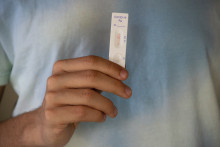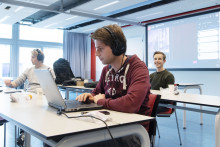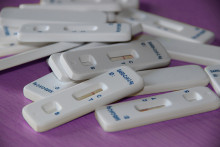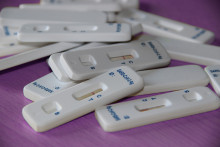‘Self-test = not stressed’ is the slogan of a new campaign. They’re hoping to convince staff and students of universities and universities of applied sciences to take a test at home before heading to campus.
It’s been possible to order these free home testing kits since 5 May from www.zelftestonderwijs.nl. The purpose of the tests is to make classroom teaching safer. It’s especially when you do not have any symptoms that you need to use a test. Anyone who does have symptoms should go straight to the community health service GGD.
Generally speaking, about 789,000 students and 106,000 staff are eligible to order tests (not counting, for example, Inholland University of Applied Sciences which is actively distributing test kits). As of Monday, 31 May, 213,000 students had placed orders; for staff the figure is 53,000.
Swab
A quick guestimate thus reveals that about half of staff have ordered tests and only about a third of students (allowing some leeway for work placements and part-time students). And then they have to actually use them: put the swab up their nose, twirl it around, apply drops, then wait.
Whoever ordered two or three test kits has been counted two or three times in these figures, but presumably that isn’t so many people: for each order you are sent four test kits (and from 1 June as many as eight test kits), while students and staff don’t need to visit campus that often.
Students’ willingness to self-test is therefore rather underwhelming, as already forecast by the first results of trials. In the final analysis, only 30 percent of those students at Avans University of Applied Sciences, HAS University of Applied Sciences and Koning Willem I Polytechnic approached participated in the pilot. This corroborates more or less with the number of students who have, up to now, ordered home testing kits.
Not mandatory
One of the reasons for low uptake: testing is not mandatory. Whether you test or not carries no tangible consequences, and most home tests are, by far, negative. Evidently these two reasons combined reduce student motivation.
That’s what happened in Groningen. Only a quarter of students bothered to show up at the rapid testing location. ‘One of the reasons they mentioned for not coming was the distance to the testing location’, RTV Noord writes. ‘They also had concerns about the impact of testing positive. Students understood that they wouldn’t be able to enter the examination hall, but wondered when and how they could make up the exam.’ So the testing location is closing.
At Vrije Universiteit Amsterdam the trial will continue to run through the middle of August, but ‘events seem to have overtaken’ the pilot, given the ready availability of home testing kits and vaccinations, the University disclosed. ’We see that willingness to be tested is lagging behind our expectations, because no immediate benefit has been attached to students getting tested.’ Classroom teaching continues to observe social distancing, with all the necessary restrictions.
No protest
Ministers had earmarked nearly half a billion euros for home testing in higher education, including distribution of test kits. Not a single administrator or interest group in education protested, because the money wasn’t coming out of the budget for education anyway. But there was also no one who fully defended the policy. The drive for home testing in higher education came from the government, not from educational administrators or student unions. They just wanted to get campuses open – with or without these tests.
Distribution of home testing kits turned out to be 63.5 million euros cheaper than had been forecast, according to the government’s Spring Memorandum issued last week. But testing still costs more than 400 million euros, while most students and obviously lots of staff don’t feel any need to get tested. From the reports of campuses and polls conducted by university newspapers, it seems that only a minority of those eligible are cooperating.
Journalists at Radboud University Nijmegen’s newspaper VOX asked students and staff members who had shown up on the recently re-opened campus if they had used one of the free home testing kits. The answer was ‘no’. One of the students approached was happy that testing was not mandatory, he laughed, ‘because I don’t want to have to stick a swab up my nose every time before I set foot on campus’.
Safe
By distributing home testing kits, the government wanted to ensure that it was safe to visit campus. Naturally, a prevented infection is worth a pound of cure. But since somewhere in the ballpark of three-quarters of those in a lecture hall will have passed up home testing, it doesn’t look like a particularly successful policy decision.
The Ministry of Education set up a total of seven pilots to see how on-campus contact could be made safer, but the alarming initial outcome was ignored: ministers had already decided to distribute home-testing kits.
The final results of all the trials will not be available until 1 July, the Ministry of Education reports. The eighth trial in Rotterdam didn’t get off the ground because of objections of a medical-ethical nature.
In the meantime, the vaccination campaign is now steaming ahead, meaning that there is a real threat that these results will be outdated. If everything goes well, a reasonably normal academic year with much fewer restrictions will commence in September.








